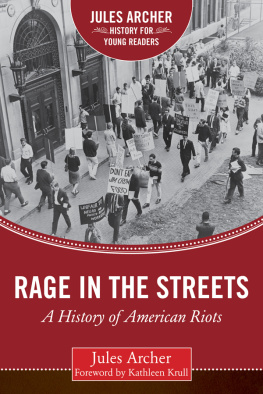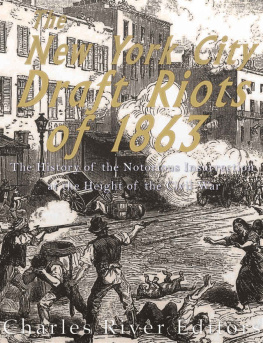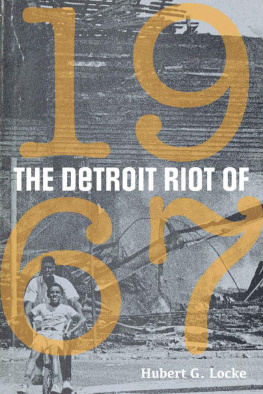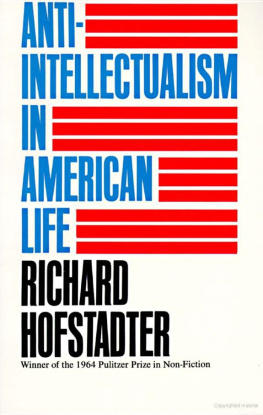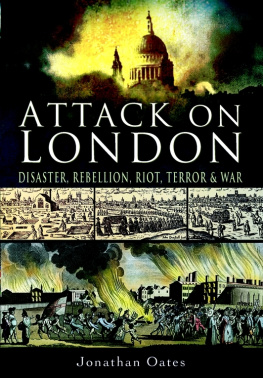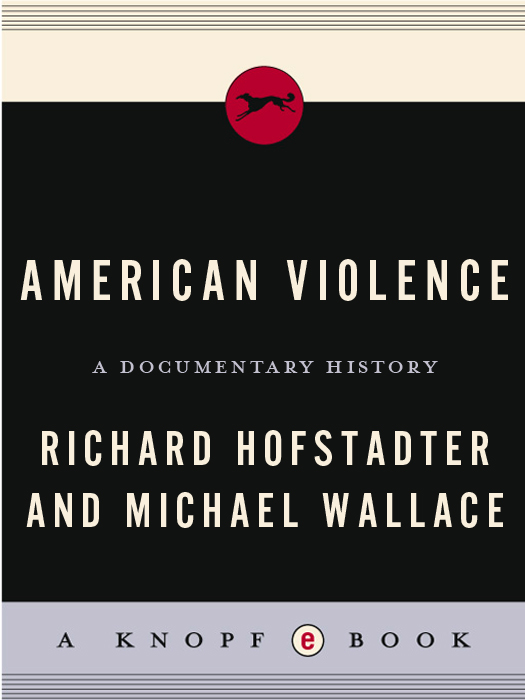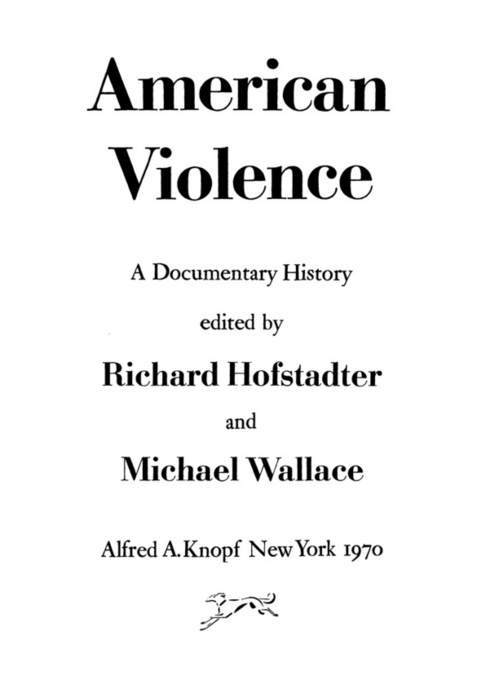ALSO BY RICHARD HOFSTADTER
The Idea of a Party System
1969
The Progressive Historians
1968
The Paranoid Style in American Politics and Other Essays
1965
Anti-intellectualism in American Life
1963
Great Issues in American History:
A Documentary Record [Three volumes]
[Volume I with Clarence L. ver Steeg]
1958, 1970
The Age of Reform
1955
The Development of
Academic Freedom in the United States
[with Walter P. Metzger]
1955
The American Political Tradition
1948
Social Darwinism in American Thought
1944
This is a Borzoi Book published by Alfred A. Knopf, Inc.
Copyright1970 by Alfred A. Knopf, Inc.
Introduction copyright1970 by Richard Hofstadter
All rights reserved under International
and Pan-American Copyright Conventions.
Published in the United States by Alfred A. Knopf, Inc.
New York, and simultaneously in Canada by Random House
of Canada Limited, Toronto. Distributed
by Random House, Inc., New York.
Library of Congress Catalog Card Number: 73111238
eISBN: 978-0-307-81400-5
v3.1
Acknowledgment is gratefully extended to the following for permission to reprint from their works:
Arno Press, Inc.: From Revolt Among the Sharecroppers, by Howard Kester, and The Great Steel Strike and Its Lessons, by William Z. Foster, 1969, Arno Press Editions.
Colonial Society of Massachusetts publication: From Tar and Feathers, The Adventures of Captain John Malcolm, XXXIV, April 1941 by Frank Hersey.
Augustus M. Kelley, Publishers: From Seventy Years of Life and Labor, by Samuel Gompers. Published in 1925 by E. P. Dutton & Co., Inc., and reprinted in 1967 by Augustus M. Kelley, Publishers.
Doubleday & Company, Inc.: From For Us. The Living, by Mrs. Medgar Evers with William Peters. Copyright1967 by Myrlie B. Evers and William Peters.
Henry E. Huntington Library and Art Gallery, San Marino, California: From Peter Olivers Origin & Progress of the American Rebellion: A Tory View, edited by Douglas Adair and John Schutz.
Look Magazine: From How a Secret Deal Prevented a Massacre at Ole Miss, by George B. Leonard, T. George Harris, and Christopher S. Wren, December 31, 1962. Copyright1962 by Cowles Communications, Inc.
An excerpt from North From Mexico by Carey McWilliams (1949) is reprinted by permission of the author.
PREFACE
At a time of unprecedented concern over American violence the value of a documentary reader on the history of our domestic violence needs little explanation. No doubt it will be most useful if the least extravagant claims are made for it, and if its role as a sampler and an introduction to a complex major problem is made entirely clear. Some explanation is needed of the principles governing the selection of material. Our subject is domestic violence. The editors have not forgotten that war is by far the most destructive of all the forms of violence; but we have not tried here to represent the history of our wars, which, unlike the history of our domestic violence, is quite familiar to educated readers and is represented in many documentary collections. However, in the belief that they shed some light on our national ways of behavior, a few episodes of gratuitous brutality in warfare with Indians and Filipino insurrectionaries have been included in Part III under the general heading of racial violence. They are rather arbitrarily classified here only because we believe that racial antagonism had much to do with them. This should not be taken to suggest that we consider such episodes to be fully explained by their racial aspect. As with warfare, we have not tried to deal with violent individual crimes but only with collective acts of violence or with individual acts, such as assassination, that have an obvious public importance. The exclusion of violent crime, once again, is an act of convenience and does not represent any conviction about its irrelevance, since the pattern of crime and the use of violence both by criminals and the police plainly shed a good deal of light upon the temper of a civilization.
Usually an episode qualifies for inclusion here because of a considerable toll in lives or extensive property destruction, or both. However, a few episodes of very limited violence, among them the Whiskey Rebellion, have been included simply because of their historical importance. At times in our history major violence has taken place with an ostensible or easily traced effect upon the course of political events; and yet there are other instances in which minor violence has had major historical consequences. We have tried to make our selections representative, without being entirely sure how, in the present state of historical inquiry, representativeness itself could be precisely determined. The many unresolved questions in the historical study of violence were a constant reminder of the tentativeness of our undertaking. A few omissions pehaps require a word of explanation: the assassination of John F. Kennedy has been left out because it has been so exhaustively reported and written about, that of Martin Luther King, Jr., because there is no eyewitness account of the act of assassination itself.
Readers are urged not to take too literally our efforts at classification, for which we claim no more than convenience and partial validity. We have been aware from the first that what we choose to call political violence often has ethnic, religious, or social overtones, that economic violence has frequently been complicated by racial or ethnic differences, and that racial violence has been inspired at times by economic rivalries. Over the whole history of American violence, indeed, the fact of racial and ethnic hatreds hovers as an ominous presence.
All those who have had occasion in any capacity to evaluate the testimony of eyewitnesses know of their fallibility; and fallibility is often magnified when especially intense emotions are involved and where horrifying experiences are endured. We do not present these documents, then, as definitive or balanced accounts. What we have looked for is material of distinctly reportorial character and value, rather than editorialized. These documents, however limited, are the kinds of materials that historians have to work with when they sift evidence. In a few instances there are factual discrepancies between our explanatory headnotes and the documentary narratives. These occur where we believe we have found in other sources sufficient reasons to depart from the document. Seventeenth- and eighteenth-century documents have been partially modernized as to capitalization and punctuation.
This book was planned jointly by the editors. A calendar of almost 2,000 violent episodes was compiled by Michael Wallace, who then searched out and assembled the documents from among many possibilities. He also did the research for the headnotes. His first drafts of headnotes were then redrafted by both editors. To their great benefit the headnotes and documents were also searchingly scrutinized and edited by Beatrice K. Hofstadter. The general introduction was written by Richard Hofstadter, who alone must be considered responsible for it. For indispensable and enthusiastic help in research the editors thank Paul Berman, David Osher, and Dennis Van Essendelft. We also acknowledge the cordial interest and cooperation of Ashbel Green and Jane Slater.


